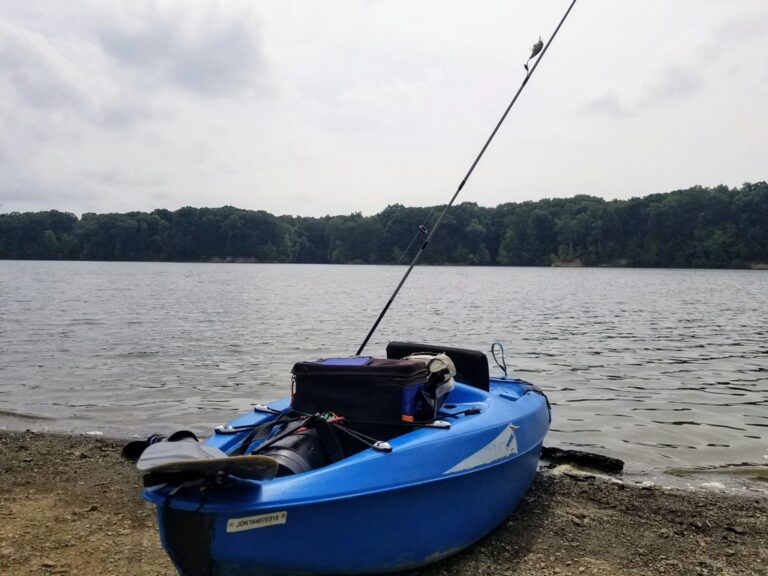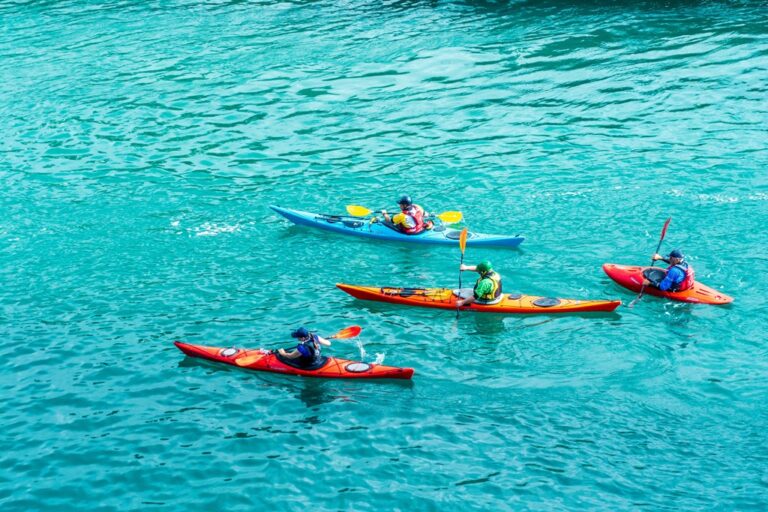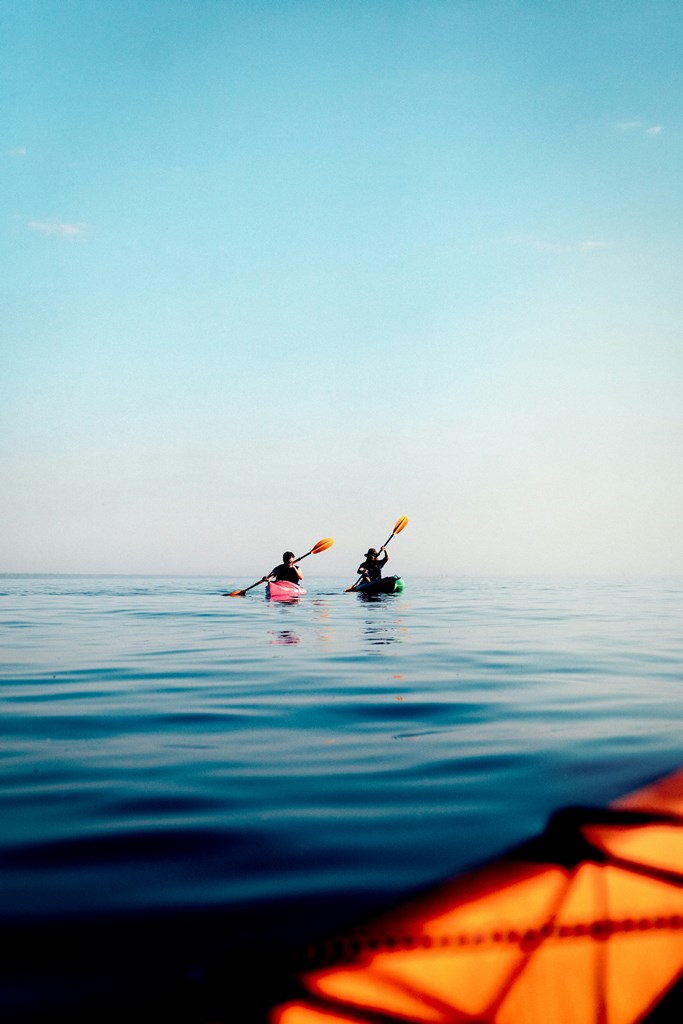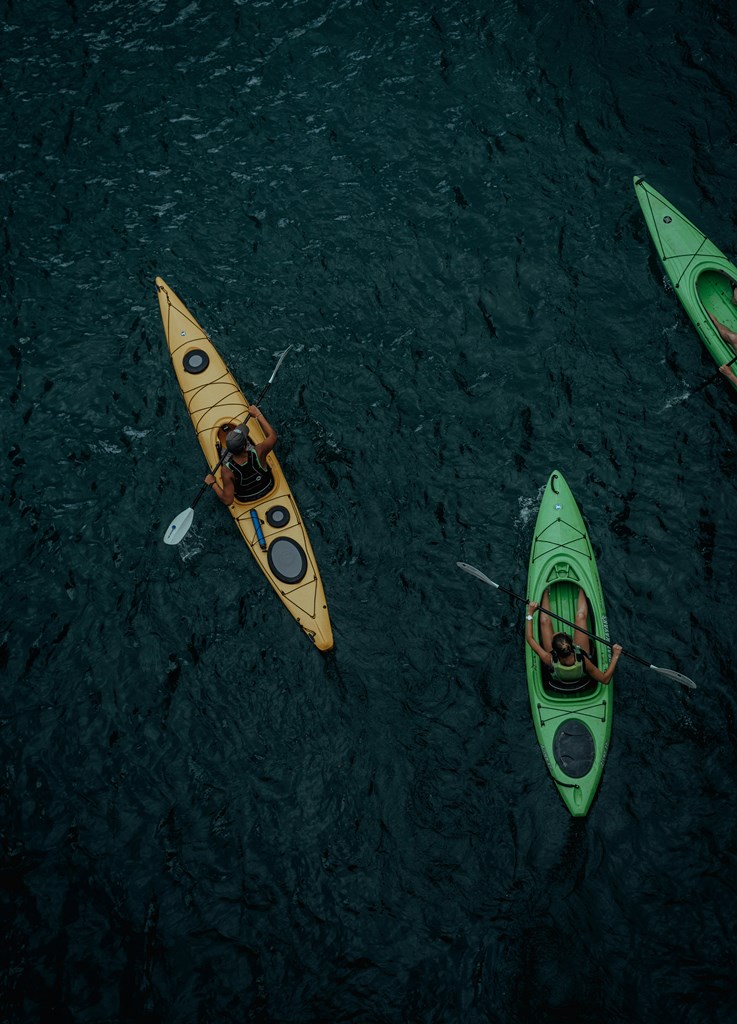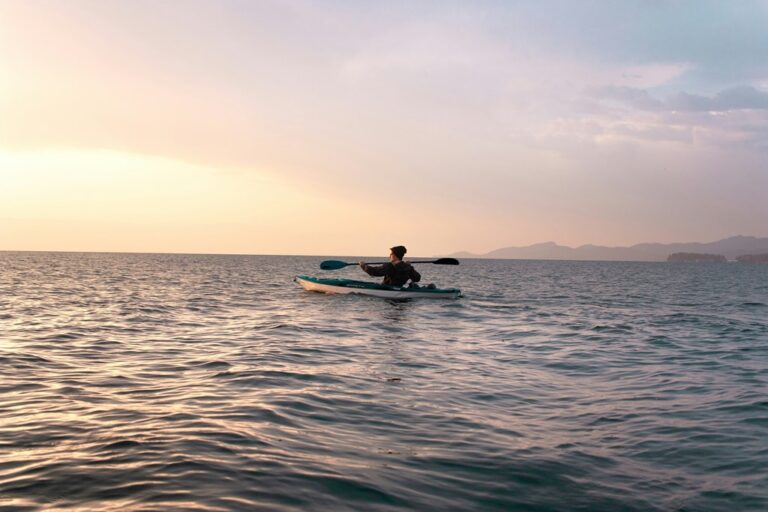
Going kayaking can be awesome, but the weather can affect your trip. This guide will help you understand what kind of weather is best for kayaking and what to do no matter what the weather throws your way.
Table of Contents
Multiple Factors Influence Ideal Kayaking Weather Conditions
The most important things to think about for good kayaking weather are:
- Wind: How strong is the wind and in which direction is it blowing from? Calm wind is best!
- Water: Is the water calm or choppy? What’s the water temperature like? Warmer and calmer water is ideal.
- Air: Is it hot, raining, or stormy? You might forget about this, but hot sun or rain can affect your trip too!
Wind is the biggest factor, so pay close attention to that one first.
Optimal Wind Speed and Direction for Kayaking

The Impact of Wind Conditions on Kayaking Performance
Wind speed significantly affects kayakers, with high speeds making paddling more strenuous and leading to quicker exhaustion.
Long-distance trips can be particularly challenging if battling strong winds, resulting in unexpected fatigue.
While minimal wind is theoretically ideal, perfect conditions are rare, necessitating strategic planning based on regional wind patterns.
Understanding seasonal changes in wind direction enables kayakers to optimize their journeys, leveraging tailwinds for assistance and planning return routes with minimal resistance.
By staying mindful of these factors, kayakers can enhance their overall experience on the water.
A Wind Speed of 10 Knots or Less is Optimal
Unlike sailing, calm waters are ideal for kayaking. A light breeze is okay, but strong winds are no fun.
Here’s a wind speed guide for kayaking:
- Beginners: Wind speeds under 10 knots (around 11 mph) are best. You’ll be able to paddle easily and enjoy your trip.
- Experienced kayakers: You can handle winds up to 20 knots (around 23 mph), but it will be harder work.
- Strong winds: It’s possible to kayak in stronger winds, but it’s very tiring and not recommended unless you’re an expert.
Also Read: When is the Wind too Strong for Kayaking?
Harnessing Wind Direction for Kayaking Success
Wind direction isn’t super important, but it can help you plan your trip. Knowing which way the wind usually blows in your area can be an advantage. Here’s a tip:
- Paddle against the wind on your way out. You’ll be fresher at the beginning of your trip, so it’s easier to fight the wind.
- Enjoy the wind pushing you back on your return. It’s a nice way to relax after your adventure!
Just remember, weather can change quickly, especially wind. This strategy might not always work, so be prepared for anything.

Optimal Temperature Range for Enjoyable Kayaking
The most important thing about water temperature for kayaking is staying safe from getting too cold. Here’s the key takeaway:
- Water below 70°F (21°C) is risky. Even strong kayakers need special winter gear for these temperatures. The right gear can help you stay warm!
There’s also a handy rule to help you decide if the water’s okay.
The “120 Rule” for Water Temperature
Staying warm is key! Cold water can be dangerous, so follow this rule:
- 120 Degree Rule: Add the air and water temperature. If it’s at least 120 degrees Fahrenheit, you should be okay with the right gear (like a life jacket and quick-drying clothes).
Not sure about the water temperature?
- Check online for data in your area.
- Ask experienced kayakers about off-season conditions.
Remember: Some people kayak year-round in cold weather, but they wear special gear like wetsuits (depending on how cold the water gets). Falling into very cold water without proper gear can lead to cold shock, which is dangerous.
Ideal Kayaking Conditions: Air Temperature Exceeding 70 Degrees
Air temperature matters, but water temperature matters more.
- Air over 70°F (21°C) is ideal. It makes using the 120-degree rule easier (air temp + water temp = 120 = comfortable kayaking with proper gear).
- Anything above 50°F (10°C) can work. But remember, this is just a general guideline. Weather changes!
- Cold water is dangerous! Even if the air feels warm, cold water can cause cold shock. Always check the water temperature before you go kayaking.
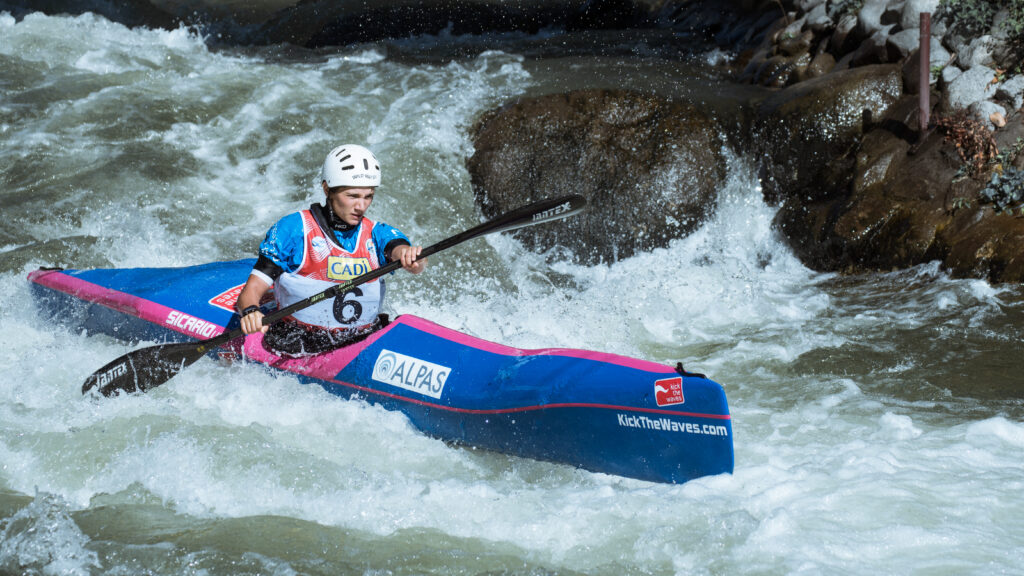
Navigating Waves, Tides, and Currents to Your Advantage
Mastering the tides is a kayaking superpower! Just like wind, paddling with the tide is easier than paddling against it. Here’s the key:
- Plan your trip to return with the tide. It’ll be a more relaxing paddle back to shore.
Tides are different everywhere. Rivers have their own currents, and oceans have tides that flow in and out. Learn the tidal patterns in your area for smooth sailing (or paddling!)
Ideal Wave Heights for Kayaking
Waves can be tricky! The height you can handle depends on your experience:
- Beginners: Stick to calm water or waves under 1 foot (about 30 cm) tall. When in doubt, play it safe! It’s better to be cautious than get tipped over.
- Experienced paddlers: You can handle bigger waves, like 2 feet (around 60 cm) tall.
Remember, judging wave height on the water can be tough. If you’re unsure and a wave looks scary, it probably is. Choose a different time to go kayaking.
Always Take Flow Rates into Account (for Whitewater Kayaking)
Whitewater kayakers, listen up! Flow rate (measured in cubic feet per second, CFS) isn’t the only thing to consider. A small river with a high CFS will be much faster than a wider one with the same CFS.
Always research the river before you go. Here’s a helpful tip: experienced kayakers use the F-O-G acronym to rate river difficulty:
- Flow: How fast is the water moving?
- Obstacles: Are there rocks, rapids, or other challenges?
- Gradient: How steep is the riverbed?
The F-O-G rating tells you how difficult a river will be. Don’t risk paddling a river that’s beyond your skill level, no matter how good the weather is!

Key Considerations When Evaluating Conditions
Weather forecasts are helpful, but they can’t tell the whole story. Here are some things to keep in mind:
- Look for specific data: Focus on wind speed, water temperature, and tide predictions.
- Local knowledge is king: Numbers on a screen can’t replace real-world experience. Check with local kayakers or boating communities for insights on current conditions.
Keep in Mind: Each Waterway Is Unique
Wind matters more on some waters than others.
- Oceans: Strong winds can be dangerous on open water. They can easily blow you off course or even out to sea. Pay close attention to wind forecasts before ocean kayaking.
- Rivers: Wind is less of a concern on rivers. If the wind picks up, you can usually find a spot to pull over and wait for it to die down.
Essential: Dressing Appropriately for the Conditions
Don’t forget the sun! Water reflects UV rays more than land, so even on cloudy days you can get a sunburn. Here’s why sun protection is essential for kayakers:
- Proper clothing: Choose sun-protective clothing that covers your arms and legs.
- Sunscreen: Apply broad-spectrum, waterproof sunscreen to all exposed skin. Reapply often, especially after swimming or sweating.
- Hat and sunglasses: Protect your head and eyes with a wide-brimmed hat and sunglasses that block UVA and UVB rays.
Cold Weather Kayaking Essentials
Stay warm, stay safe! Cold-weather kayaking requires extra protection to avoid hypothermia. Here are some key clothing items (depending on how cold your paddling area gets):
- Wetsuit: This is your first line of defence against cold water.
- Warm layers: Choose quick-drying thermals and fleece for your core.
- Footwear: Keep your feet toasty with wool socks and waterproof paddling boots.
- Hand protection: Wool or neoprene gloves will shield your fingers from the chill.
- Wind protection: An outer layer like a dry suit or windbreaker will block wind and keep you warm.
- Dry bag with spare clothes: Pack a change of dry clothes for emergencies and extra warmth after your trip.
Kayaking in Hot Weather Conditions
Beat the heat! Just like cold weather, hot weather kayaking requires specific gear to avoid sunstroke (heatstroke). Here’s how to stay cool and comfortable:
- Sun protection is key: Check the UV index before you go and wear:
- Sun hat: A wide-brimmed hat protects your head and face.
- Sunglasses: Look for sunglasses that block UVA and UVB rays.
- Sun-protective clothing: A white, long-sleeved top reflects sunlight and protects your skin.
- Stay cool and hydrated:
- Dry tops: These lightweight, water-resistant tops can help keep you cool while protecting you from splashes.
- Drink plenty of water: Stay hydrated throughout your trip to avoid overheating.
Double Check the Weather Forecast
Be weather-aware! Weather can change quickly, so staying informed is key to a safe and enjoyable kayaking trip. Here are some tips:
- Check the forecast regularly: Don’t rely on a single check. Look throughout the day, especially before you head out.
- Double-check the forecast: Look for marine forecasts if you’re ocean kayaking.
- Ideal wind conditions: Look for forecasts with “calm,” “light air,” or “light breeze” and avoid strong winds.
- Temperature matters: For larger bodies of water, check water and air temperatures (and use the 120-degree rule to see if it’s comfortable).
- Read the clouds: Clouds can mean shade on a sunny day or a potential storm brewing.
- Weather apps: There are many great apps to get real-time weather updates. Here are a few suggestions (consider removing specific app names based on your website’s policies):
- Weather radar apps
- Tide chart apps
- General weather forecast apps
- Marine navigation apps (for ocean kayakers)
By following these tips, you’ll be better prepared for whatever the weather throws your way!
Always Remember Essential Safety Gear
Be prepared for anything! Even on a perfect weather day, there’s always a chance of unexpected conditions. Here are some essential supplies to pack for every kayaking trip:
- Personal Flotation Device (PFD): This is your most important safety item. Wear it properly at all times!
- Sunscreen: Protect yourself from harmful UV rays, even on cloudy days.
- Snacks and Water: Stay hydrated and fueled for your adventure. Pack enough water and snacks to last your entire trip.
- Signalling Whistle: A whistle is a universal distress signal that can help you get attention in an emergency.
- Spray Skirt (optional for calmer water): This keeps water out of your kayak and helps you stay comfortable. It’s especially important in choppy conditions.
Key Points to Remember
- Calm winds are key: Aim for wind speeds of 10 knots (around 11 mph) or less. Bonus points if you can paddle with the wind at your back on the way back to shore!
- Comfortable temperatures: Ideally, both air and water temperatures should be around 70°F (21°C). Dress appropriately for colder weather to stay safe.
- Know your water: Check for wave heights, tides, currents, and flow rates (especially for rivers). Choose conditions that match your skill level.
Conclusion
Weather happens, but with a little planning, you can make the most of any kayaking trip! Understanding weather conditions builds knowledge and keeps you safe. By checking forecasts and water conditions, you’ll be prepared for anything the water throws your way.
Happy paddling!

